Your Keto Meal Plan Isn’t Working Because You’re Missing These Hidden Metabolic Triggers
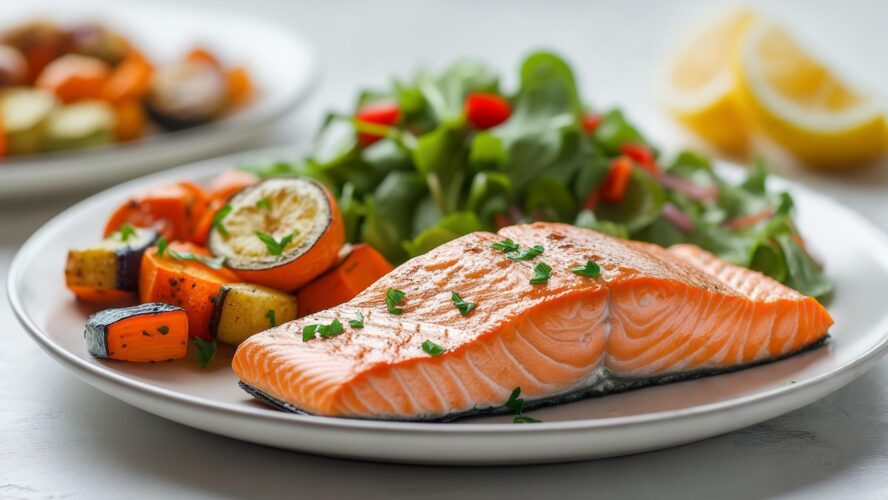
Table of Contents
- The Real Reason Your Keto Meal Plan Keeps Failing
- Why Timing Beats Food Choices Every Single Time
- The Metabolic Flexibility Secret Nobody Talks About
- Your Gut Is Secretly Making Ketones (And You’re Probably Sabotaging It)
- How to Actually Measure What’s Working in Your Body
- Building a Meal Plan That Adapts to Your Real Life
TL;DR
- Your body naturally produces ketones throughout the day, and I’ve found that when you eat matters just as much as what you eat
- That morning energy boost you get? There’s a perfect window where your body is primed to turn fat into fuel
- Taking a planned break from strict keto every month or so can actually make you better at burning fat
- Your gut bacteria are basically little ketone factories, but you probably don’t know how to feed them properly
- Paying attention to how you feel gives you better feedback than expensive blood tests
- Most keto plateaus happen because you’re eating the same foods over and over, not because you’re eating too much
The Real Reason Your Keto Meal Plan Keeps Failing
Let me guess – you’ve tried keto before, lost some weight initially, then hit a wall where nothing seemed to work anymore. You’re eating all the “right” foods, tracking everything religiously, but your energy is inconsistent and the scale won’t budge. Sound familiar?
I’ve been there too – meticulously tracking every gram of fat, protein, and carbs, yet still feeling like my keto meal plan was working against me. Turns out, I was missing the bigger picture entirely.
Your body doesn’t just process food in isolation. It processes food within the context of your daily rhythms, stress levels, and sleep patterns that most keto meal plans completely ignore. When you understand these patterns, everything changes.

Here’s what I’ve learned: a keto diet plan limiting carbs to “less than 20 grams of net carbs per day” (Diet Doctor) can definitely help with fat burning and weight loss. But this one-size-fits-all keto diet plan approach misses the crucial element of figuring out your personal timing.
Understanding your individual carb tolerance is crucial for creating an effective keto diet plan, and once you know that, you can start optimizing when you eat for better results.
Why Your Morning Routine Determines Your Entire Day’s Energy
You know that natural energy boost you get in the morning? It’s not just waking you up – it’s creating the perfect environment for your body to turn fat into fuel. But only if you know how to work with it.
I started checking my ketone levels every morning for a week (yeah, it was kind of tedious, but stick with me here). What I discovered changed everything about how I approach my first keto meal of the day.
Your body’s natural wake-up hormones typically peak between 8-9 AM, and this is when you’re primed to convert fats into ketones most efficiently. The trick is getting the right fats into your system about 30 minutes before this peak hits.
Try this tomorrow: Have your coffee with a tablespoon of coconut oil or MCT oil around 7:30 AM, then pay attention to how you feel by 10 AM. You’ll likely notice more stable energy compared to your usual routine.
Some people do better with coconut oil, others with straight MCT oil. The only way to know is to try both and see which one makes you feel better throughout the morning.
Sarah, a 34-year-old marketing executive, was struggling with those brutal afternoon energy crashes despite following a strict keto meal plan. After we figured out her natural rhythm and she started having 1 tablespoon of MCT oil at 7:30 AM, her energy stayed steady all day. No more 3 PM coffee runs or sugar cravings.
The Evening Carb Trick That Actually Enhances Fat Burning
This one’s going to sound backwards, but hear me out. Eating a small amount of carbs in the evening can actually improve your fat burning the next day.
When your sleep hormone rises in the evening, it can sometimes trigger your body to store fat instead of burn it. But 10-15g of the right carbs (think a small sweet potato or some berries) eaten about 3 hours before bed can prevent this while actually helping you sleep better.
I pair this with some magnesium, which helps you need less melatonin to get quality sleep. The result? Better sleep and more energy the next morning.
Pay attention to your sleep quality and morning energy for a week while trying this. Most people are surprised by how much better they feel when they stop being afraid of every single carb.
The Simple Meal Order That Changes Everything
Here’s something that completely shifted my approach to keto meal planning: the order you eat your food matters more than the food itself.
Starting your keto meals with protein – especially proteins with lots of amino acids like beef, salmon, or bone broth – tells your body to burn fat before your insulin kicks in. This creates the perfect environment for ketone production, even when you’re eating more protein than traditional keto guidelines suggest.
I now start every keto meal with a few bites of grass-fed beef, wild-caught salmon, or some bone broth. Then I move to fats, and finish with any vegetables or small amounts of carbs. The difference in how I feel after keto meals is remarkable. No more post-meal crashes, and my energy stays more stable throughout the day.
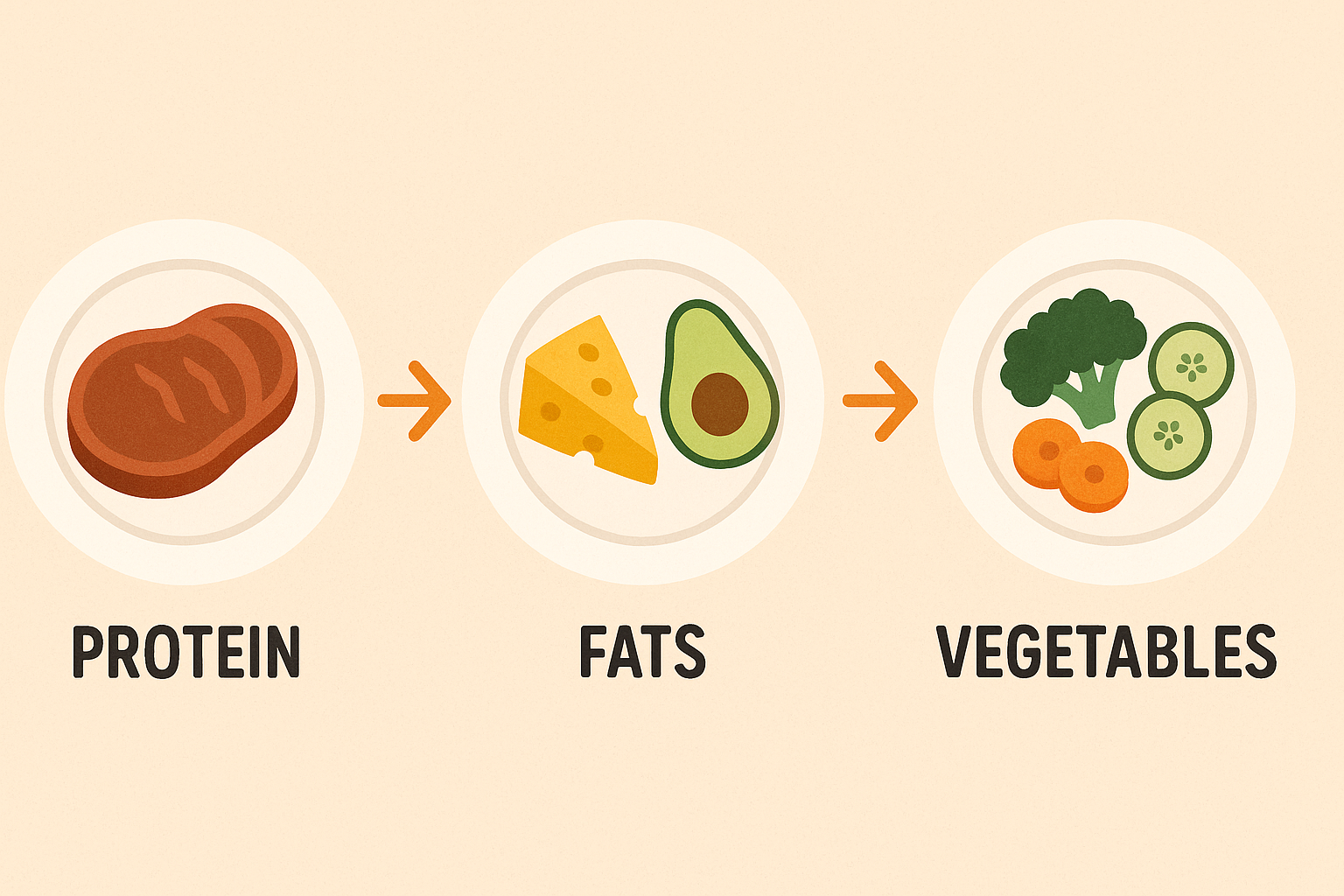
Why Timing Beats Food Choices Every Single Time
Most people think successful keto means staying in deep ketosis 24/7. That’s actually counterproductive for long-term success with any keto diet plan.
Your body is designed to be flexible – meaning it should efficiently switch between burning carbs and fat depending on what’s available. When you force constant ketosis, you can actually make this switching process worse over time.
While many people focus on eliminating foods, learning intermittent fasting strategies can really help with the timing aspect of your ketogenic meals.
Well-planned meal schedules with proper timing show significant improvements in how you feel. For example, structured meal plans with good sequencing deliver “1300cal, 114g protein, 12g net carbs, 83g fat, 11g fiber per day” (Strongr Fastr) while keeping your energy steady through strategic nutrient timing.
The Simple Carb Cycling Method That Supercharges Fat Burning
After 4-6 weeks of consistent keto, I do something that sounds crazy: I intentionally eat carbs for a couple days.
This isn’t a cheat weekend where you go nuts – it’s a planned break that actually helps. During these 48 hours, I eat 100-150g of carbs from sweet potatoes, white rice, and fruits.
What happens next is pretty cool. When I go back to ketogenic eating, I get back into ketosis faster and deeper than before. It’s like giving your fat-burning machinery a reset that actually improves how well it works.
The first time I tried this, I was terrified I’d undo weeks of progress. Instead, I came back stronger. My energy was higher, more stable, and food cravings basically disappeared.
Here’s how I rotate my carb cycling – it’s way simpler than it sounds:
- Stick to regular keto for about a month
- Then eat some sweet potatoes and rice for two days (yes, really!)
- Go back to keto for 3-5 days to get back in
- Continue with regular keto for another month
Using Cold Showers to Boost Your Results
Cold exposure and keto meal timing create this powerful combination that most people never try.
I started taking cold showers 30 minutes after my morning fat intake. The combination activates your body’s natural fat-burning while your ketones are already elevated, creating this incredible energy surge that lasts for hours.
The metabolic benefits of cold exposure align perfectly with cold shower therapy, and when you combine it with strategic keto meal timing, the effects are even better.
The key is timing. Cold exposure on an empty stomach can be stressful and make you feel worse. But when you already have ketones flowing from strategic fat intake, cold becomes an energy amplifier rather than a stressor.
Start with 30 seconds of cold water at the end of your regular shower, then gradually work up to 2-3 minutes. You’ll notice the benefits build over time.
Exercise Timing That Actually Works With Your Keto Schedule
Exercise timing on keto isn’t just about performance – it’s about optimizing when your body makes ketones within your keto meal plan.
I do short, intense workouts twice a week while fasted, specifically to increase my body’s ability to make ketones. These sessions are brief (15-20 minutes) but intense enough to use up stored carbs and force my body to become more efficient at making ketones.
After these workouts is when I eat my highest protein keto meal. Your body absorbs amino acids better for several hours after intense exercise, so this is the perfect time to eat more protein without worrying about it interfering with ketosis.
Easy movement works differently. I use gentle walks in a fed state to help my body use ketones better rather than make more. A 20-minute walk after keto meals helps get ketones into cells more efficiently.
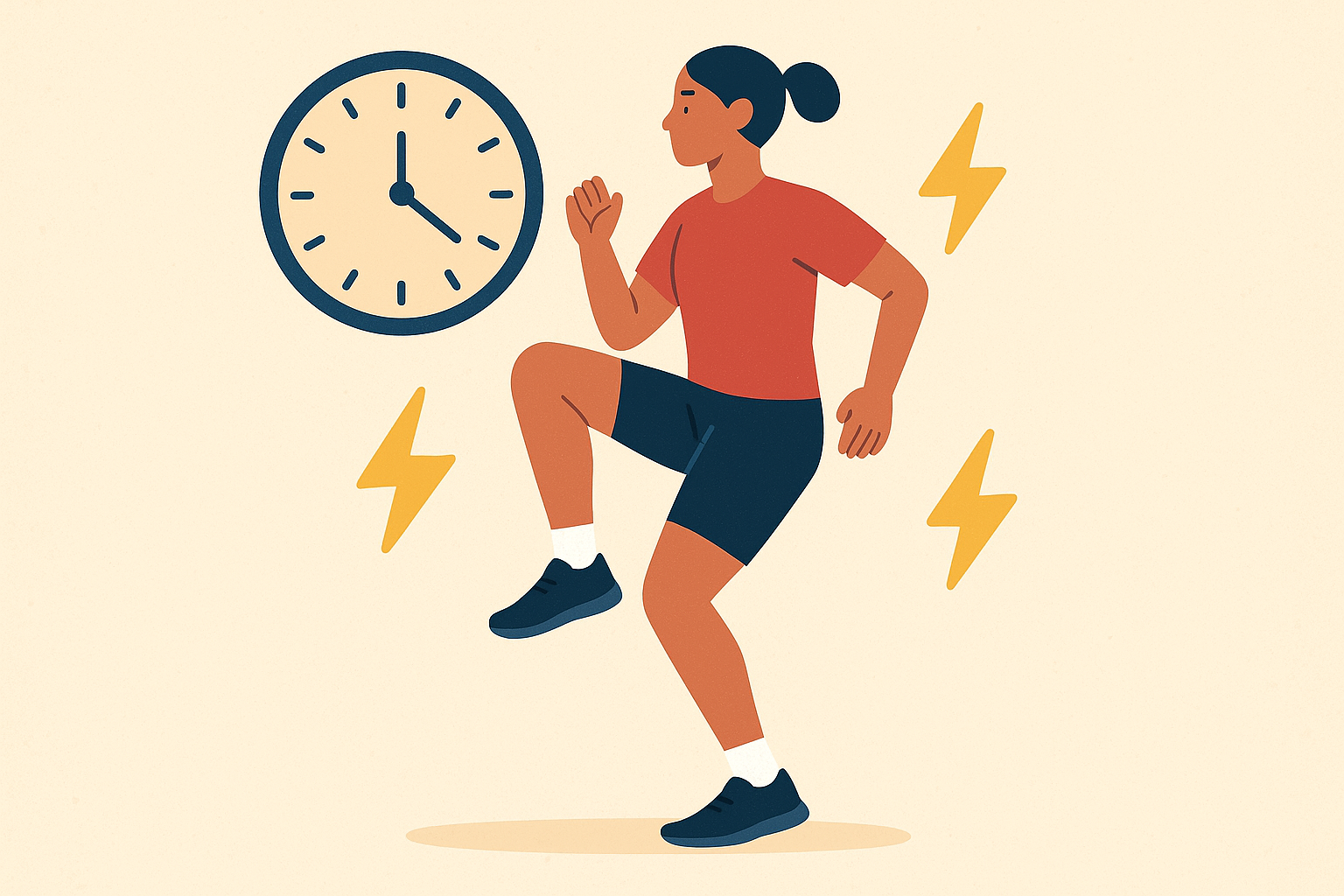
The Metabolic Flexibility Secret Nobody Talks About
Your gut is making ketones right now, and you probably have no idea.
Certain bacteria in your digestive system produce ketones completely separate from your liver. When you feed these bacteria the right foods, you can significantly boost your total ketone production without changing anything else about your ketogenic diet meal plan.
Supporting gut health becomes even more important on keto, and drinking vinegars can help your gut bacteria produce ketones while improving digestion.
The “21-Day Keto Reset” (The Daily World) program gets this connection, emphasizing how “the body shifts from using carbohydrates as its primary energy source to burning fat” while supporting beneficial gut bacteria through smart food choices.
The Resistant Starch Trick That Boosts Ketones
This is where things get interesting. Resistant starch – found in cooled potatoes or green bananas – feeds bacteria that produce butyrate, which is actually a type of ketone.
I add 10-15g of resistant starch daily, usually from green banana flour or potato starch. The bacteria that eat this produce butyrate that goes directly to fuel my gut lining and brain cells.
The resistant starch thing sounds weird, I get it. I felt ridiculous buying green banana flour at first. But when my energy stopped crashing every afternoon, I stopped caring about looking like a health nut.
Fermented vegetables are the other piece of this puzzle. Sauerkraut, kimchi, and other fermented foods contain specific bacteria strains that are particularly good at producing ketones.
The key is consistency. It takes 2-3 weeks to see significant changes in your gut bacteria, but once these bacteria establish themselves, they become a reliable source of ketones that doesn’t depend on how much fat you’re eating.
Mike, a 42-year-old engineer, added 1 tablespoon of potato starch and 1/4 cup of sauerkraut to his daily keto meals routine. After 3 weeks, his baseline energy improved noticeably without changing any other dietary factors, showing the power of gut bacteria-driven ketone production.
How Your Nervous System Communicates Energy Status
Your vagus nerve is constantly sending signals to your brain about your energy status. When this communication is working well, you experience better mental clarity, stable mood, and natural appetite regulation.
Certain eating habits improve this nerve function and help your brain understand what fuel is available. Eating slowly, chewing thoroughly, and taking deep breaths between bites all stimulate this nerve and improve its ability to communicate energy availability to your brain.
I’ve noticed that when I eat mindfully and focus on slowing down during my keto meal, my mental clarity improves dramatically within 30-60 minutes. Your brain is getting a clearer signal about what fuel sources are available.
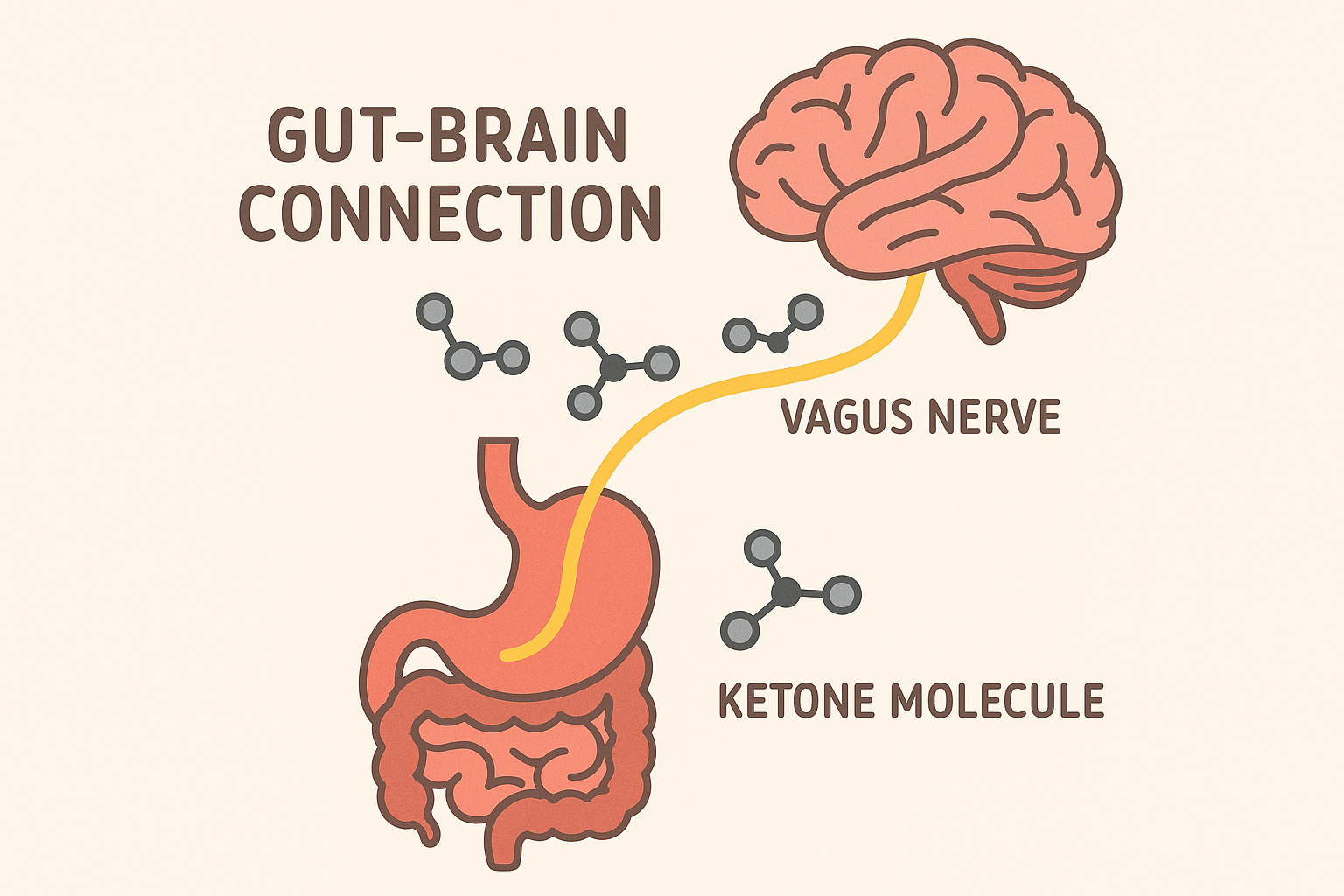
The Brain Chemistry Connection
Ketones don’t just fuel your brain – they directly influence brain chemical production in ways that can dramatically improve your mental state.
Specific amino acids combined with ketones enhance GABA production, which reduces anxiety and improves sleep quality. This is particularly important when you’re transitioning to ketogenic meals and many people experience increased anxiety or sleep issues.
I focus on glycine-rich foods (bone broth, gelatin) in the evening when my ketones are typically higher. The combination creates this calm, relaxed feeling that makes falling asleep much easier.
Your brain’s reward system is the other crucial piece. Your brain can become less sensitive to the same fat sources over time, leading to decreased satisfaction and increased cravings.
I rotate between 3-4 primary fat sources weekly – avocado, olive oil, nuts, and coconut products – and introduce new fat sources monthly. This keeps my brain intereste
I rotate between 3-4 primary fat sources weekly – avocado, olive oil, nuts, and coconut products – and introduce new fat sources monthly. This keeps my brain interested and maintains the pleasure I get from keto meals.
Pay attention to your mood and cravings while trying different rotation schedules. You’ll quickly figure out what works best for your brain chemistry.
Your Gut Is Secretly Making Ketones (And You’re Probably Sabotaging It)
Generic keto advice fails because everyone’s body is different. What works for your friend might sabotage your progress, and the only way to know is through trying things out and seeing what works for your unique situation.
I spent months following cookie-cutter keto meal plans before I realized I needed to become the expert on my own body’s patterns.
Optimizing digestion becomes crucial for ketone production, and improving digestive health can significantly enhance your body’s ability to produce and use ketones effectively.
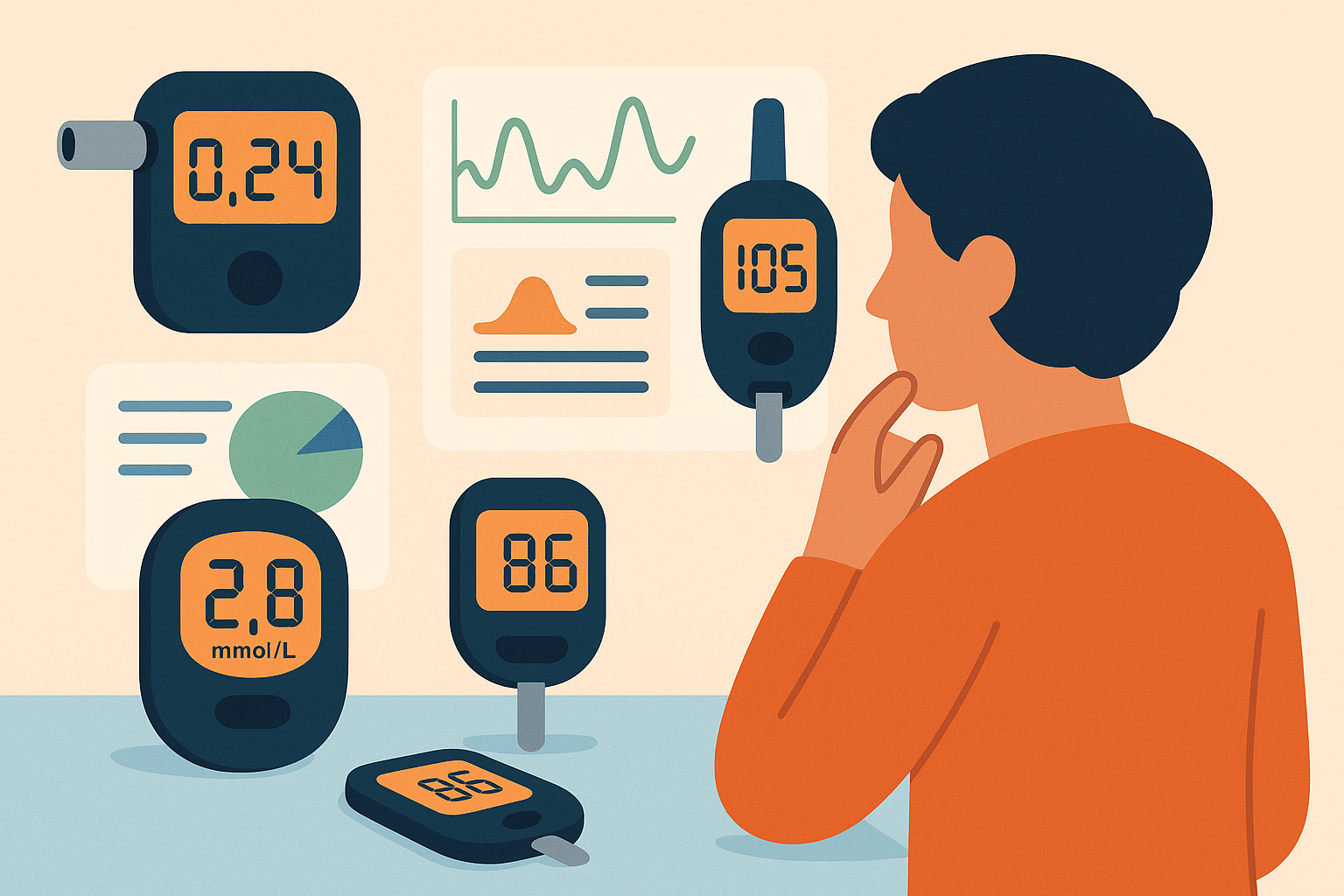
Why Paying Attention Beats Expensive Testing
Blood ketone strips are expensive and only give you a snapshot. Paying attention to how you feel tells you what’s happening with fat burning in real-time, which is much more useful for keto meal planning decisions.
I did invest in a breath ketone analyzer and started testing before and after each keto meal for a week. The patterns that emerged were eye-opening.
Some foods that were technically “keto-friendly” actually made me feel worse, while others that seemed questionable actually gave me more energy. Without paying attention, I never would have discovered these individual responses.
How you feel also responds faster to changes than blood tests, so you can make immediate adjustments to your next keto meal based on how your body responded to the last one.
Strategic meal planning with proper balance shows measurable results. Well-structured plans typically deliver “2475cal, 192g protein, 27g net carbs, 170g fat, 18g fiber per day” (Strongr Fastr), but individual responses vary significantly based on timing and personal factors.
The Simple Ratio That Tells You If You’re Actually Burning Fat
Looking at blood sugar and ketones separately misses the bigger picture. The simple ratio between them tells you much more about what’s actually happening in your body.
A low ratio indicates deep fat burning, while a higher ratio suggests you’re primarily burning glucose. But here’s what’s interesting: the optimal range varies by person and by what you’re trying to accomplish.
I track this ratio throughout the day and have learned that my brain function is best when the ratio is low, while my physical performance peaks when it’s slightly higher.
This knowledge allows me to time different activities and adjust my keto meals accordingly. Need deep focus for work? I aim for a lower ratio. Planning a workout? I let it drift up a bit.
Simple Optimization Steps:
- Test blood sugar and ketones at the same time
- Calculate the simple ratio (blood sugar ÷ ketones ÷ 18)
- Notice optimal ranges for different activities
- Adjust meal timing based on your target ratio
- Track patterns over 2-3 weeks
- Fine-tune based on how you perform
Finding Your Personal Food Troublemakers
Even “keto-friendly” foods can sabotage your progress if they don’t work well with your specific body.
I started paying attention to inflammation markers while systematically testing different foods. What I discovered was shocking – some foods that were staples in my keto meal plan were actually creating low-grade inflammation that hurt my ketone production.
Nuts were a big culprit for me. Despite being high-fat and low-carb, certain nuts consistently made me feel worse and decreased my energy levels. Once I eliminated them, my ketosis became much more stable.
Heart rate variability is another powerful tool for this if you want to get fancy. Your HRV reflects how your nervous system responds to different foods, giving you real-time feedback on keto meal compatibility.
I established a baseline HRV for one week while eating consistently, then introduced new foods one at a time while monitoring changes. Foods that decreased my HRV got eliminated from my meal rotation, while those that improved my HRV became staples.
This process helped me create a personalized “green light” food list that’s unique to my body. Your list will likely be different, which is why this individualized approach is so important.
Jennifer, a 38-year-old teacher, discovered through simple tracking that almonds consistently made her feel sluggish and reduced her afternoon energy. After eliminating almonds and replacing them with macadamia nuts, her energy stability improved dramatically throughout the day.

How to Actually Measure What’s Working in Your Body
Most keto meal plans are static documents that don’t adapt to your changing life circumstances. Real success comes from building flexible systems that work whether you’re stressed, traveling, or dealing with social situations.
I learned this the hard way after abandoning multiple rigid meal plans that couldn’t accommodate my actual lifestyle.
Creating sustainable habits requires understanding your body’s stress responses, and recognizing stress patterns can help you adjust your meal timing for optimal ketone production during challenging periods.
Flexible meal planning systems show better long-term results. Structured approaches that account for real life, like plans providing “1275cal, 100g protein, 12g net carbs, 88g fat, 11g fiber” (Strongr Fastr) with built-in modification options, work better than rigid protocols.
Building Your Go-To Recipe Collection
Instead of collecting hundreds of random ketogenic diet recipes, I created a master list of 20 base meals that I genuinely enjoy eating. Then I developed three versions of each one.
Quick versions (10 minutes) for busy days when I need fuel fast. Standard versions (30 minutes) for normal meal prep. Elaborate versions (60+ minutes) for weekends when I want to enjoy the cooking process.
Each recipe also gets a rating based on how it affects my energy production. High-impact recipes are reserved for days when my energy is running low, while maintenance recipes work well when I’m already feeling good.
This system means I never have to think about what to eat or worry about whether a meal will support my goals. The framework makes decisions automatic.
Simple Recipe Organization:
Breakfast Options:
- Quick: Scrambled eggs + avocado (10 min)
- Standard: Bacon omelet with spinach (30 min)
- Elaborate: Keto pancakes with berries (60+ min)
Lunch Options:
- Quick: Tuna salad lettuce wraps (10 min)
- Standard: Chicken Caesar salad (30 min)
- Elaborate: Zucchini lasagna (60+ min)
Dinner Options:
- Quick: Pan-seared salmon (10 min)
- Standard: Stuffed chicken thighs (30 min)
- Elaborate: Beef wellington keto-style (60+ min)
Emergency Options:
- Protein shake + MCT oil
- Hard-boiled eggs + olives
- Bone broth with collagen
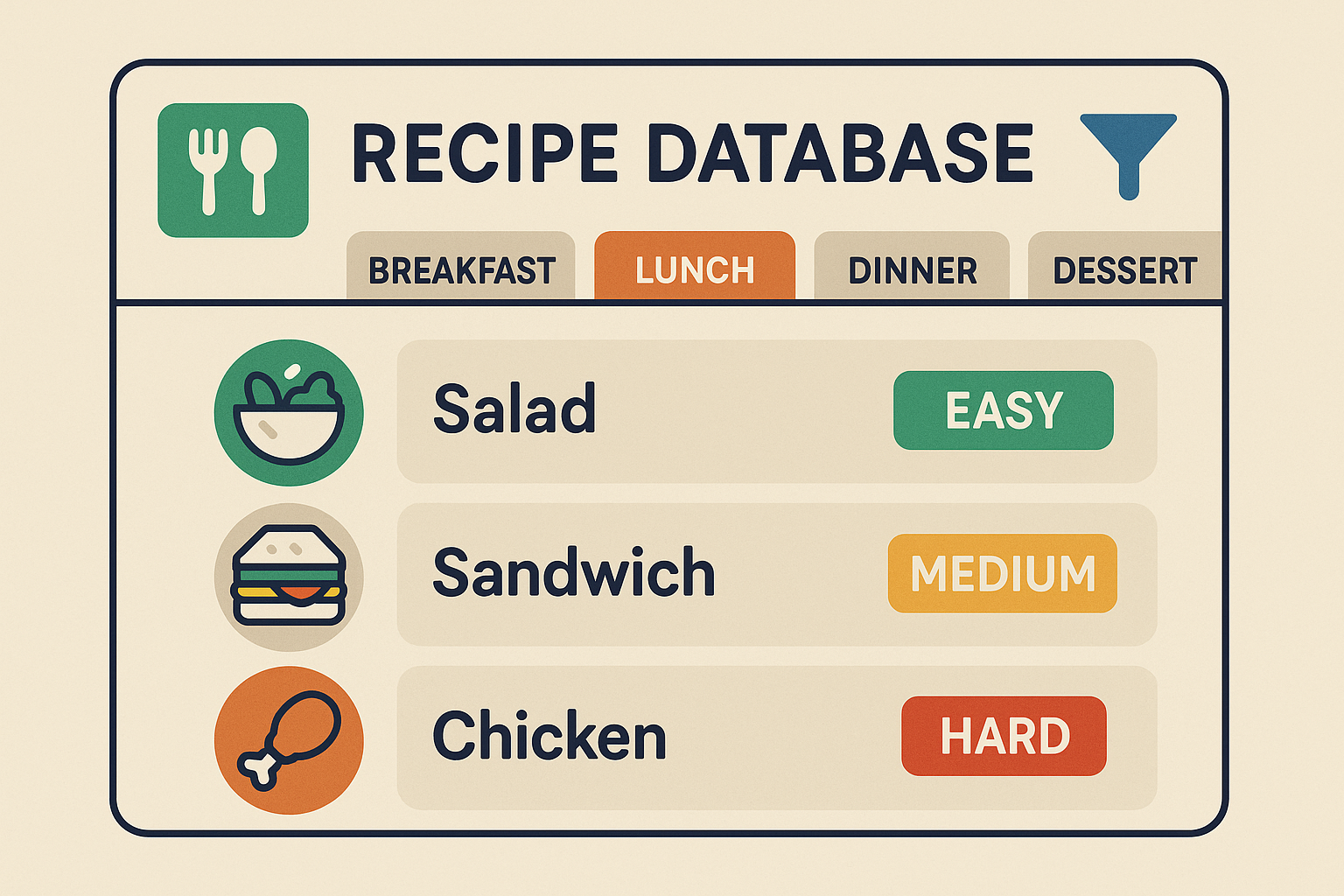
Seasonal Adjustments That Actually Make Sense
Your ketone production isn’t constant throughout the year. Light exposure, temperature changes, and natural food availability all influence your metabolic patterns.
In winter, I naturally crave more fats and my ketone production tends to be higher. Summer brings increased carb cravings and slightly lower baseline ketones, which is completely normal and healthy.
Instead of fighting these patterns, I adjust my keto meal plan seasonally. Winter meals are higher in saturated fats and warming spices. Summer meals include more cooling foods and slightly higher vegetable content.
This seasonal approach prevents the stagnation that comes from eating identical meals year-round.
Winter Focus:
- More saturated fats (butter, coconut oil)
- Warming spices (cinnamon, ginger, turmeric)
- More bone broth and stews
- Less raw vegetables, more cooked options
Summer Focus:
- More cooling foods (cucumber, mint)
- Higher raw vegetable intake
- Electrolyte-rich foods for hydration
- Lighter, fresher preparations
Handling Common Meal Plan Disasters
Social situations used to completely derail my keto efforts until I developed simple strategies for handling them.
I used to stress about every social meal until I realized most people don’t actually care what you’re eating. Bring some nuts, eat beforehand, or just focus on the company instead of the food.
My portable emergency kit is simple: nuts, beef jerky, and those little olive oil packets you can get anywhere. That’s usually enough to avoid food disasters when perfect options aren’t available.
Weight loss plateaus almost always result from eating the same foods repeatedly, not from eating too much. When progress stalls, I rotate completely different protein and fat sources for 2-3 weeks. This usually breaks the plateau without requiring calorie restriction.
Travel requires its own system. I identified 10 shelf-stable keto components available almost anywhere: canned fish, nuts, olive oil packets, avocados, eggs, cheese, olives, coconut products, dark chocolate, and bone broth powder.
I also looked up keto-friendly restaurant chains in my common travel destinations and created travel-day keto meal templates that account for disrupted eating schedules.
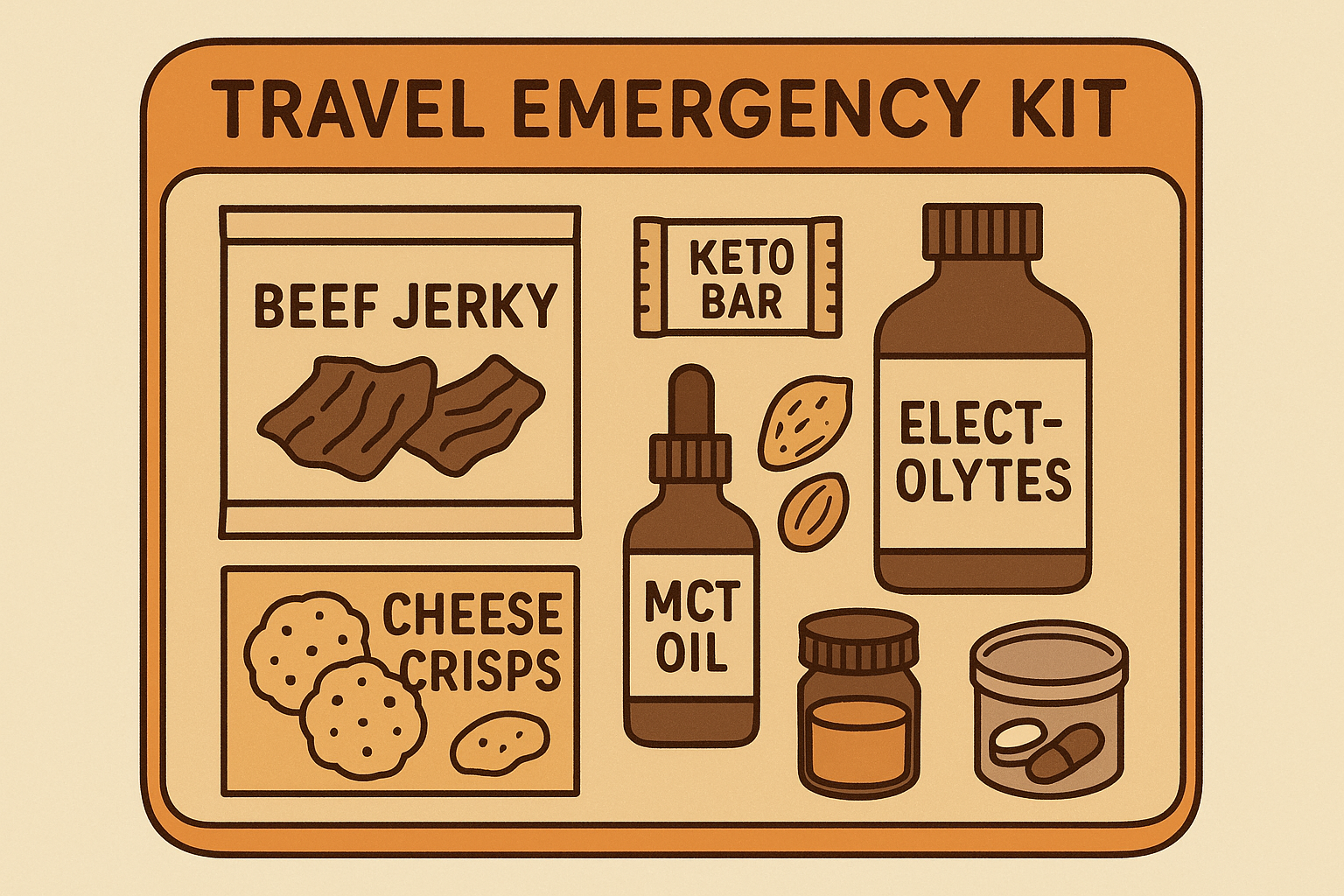
Building a Meal Plan That Adapts to Your Real Life
The goal isn’t perfect adherence to a rigid keto meal plan – it’s building a flexible system that supports your health while fitting into your actual life.
After years of trial and error, I’ve learned that sustainability comes from having multiple options and backup plans, not from trying to control every variable.
Some days I nail the timing perfectly. Other days I’m eating leftover keto pizza at 10 PM because life happened. The goal isn’t perfection – it’s having a system that works even when things get messy.
Your keto meal plan should evolve as you learn more about your body’s responses. What works in month one might need adjustment by month six, and that’s completely normal.
The key is maintaining the underlying principles – strategic timing, personalized food choices, and paying attention to patterns – while allowing the specific implementation to adapt to your changing needs and circumstances.
I know this might sound like a lot, but don’t try to do everything at once. I made that mistake and nearly drove myself crazy. Pick ONE thing that sounds doable and try it for a week.
Simple Implementation Plan:
Week 1-2: Start Simple
- Pay attention to your natural energy patterns
- Try eating protein first at meals
- Create a simple emergency food kit
- Notice how different foods make you feel
Week 3-4: Add One Thing
- Test morning fat timing strategies
- Start tracking sleep and energy patterns
- Identify foods that consistently make you feel good or bad
- Develop 5 go-to keto meal templates
Week 5-8: Get More Strategic
- Try seasonal adjustments
- Test the carb cycling approach
- Optimize exercise timing
- Build your adaptive recipe collection
Week 9-12: Fine-Tune Everything
- Dial in your personal ratios for different activities
- Create travel protocols
- Develop social situation strategies
- Build your long-term monitoring system
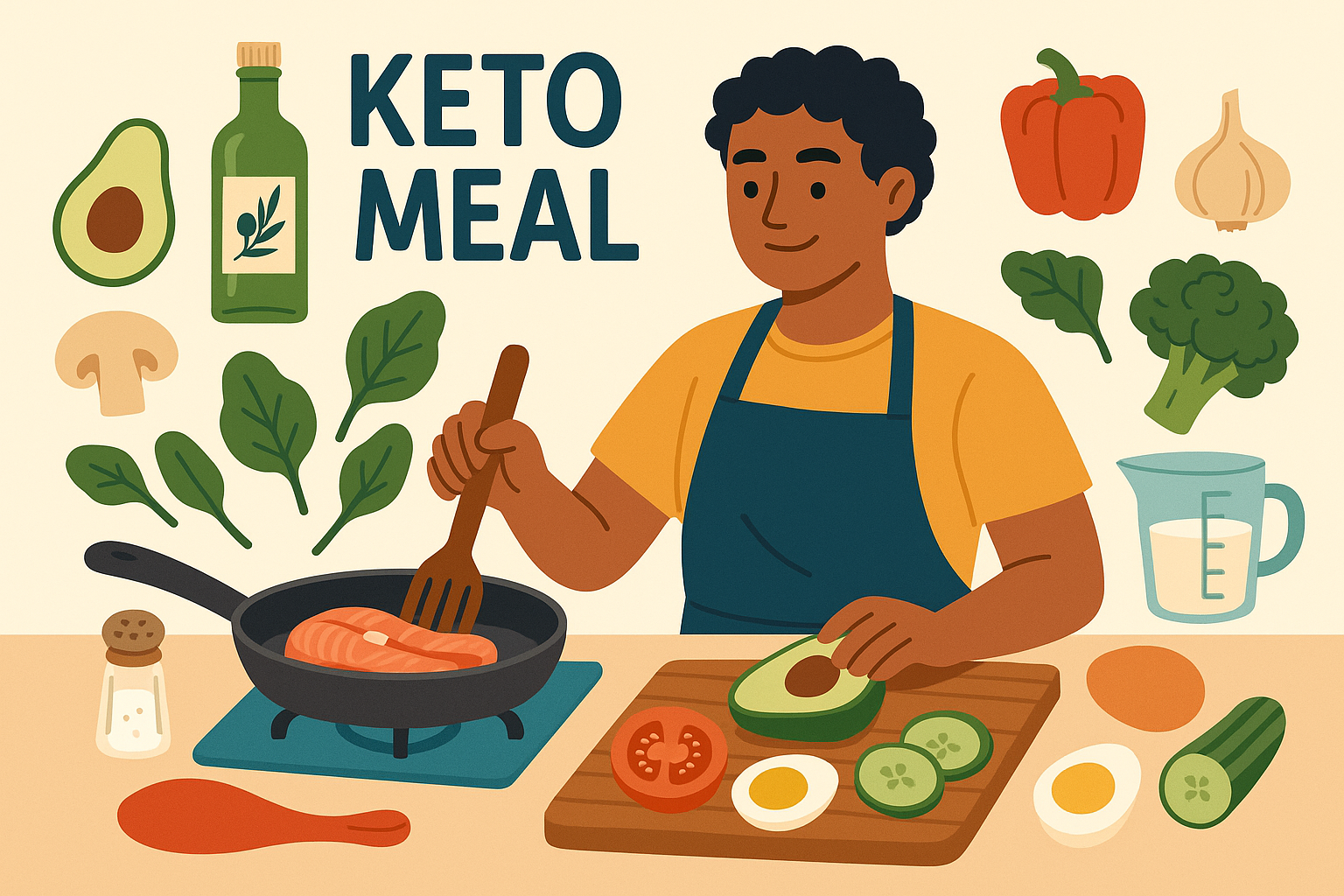
Look, some of this testing stuff costs money if you want to get fancy with it. Start with just paying attention to how you feel. The expensive gadgets can come later if you want them, but your body will tell you most of what you need to know.
If you’re interested in the testing and monitoring aspects of this approach, Organic Authority offers high-quality ketone testing supplies and metabolic support supplements that can simplify the process of optimizing your individual keto meal plan. Their commitment to rigorous testing and bioavailable nutrition aligns perfectly with this personalized approach to ketogenic eating.
Final Thoughts
Your keto meal plan doesn’t have to be a constant struggle against your body’s natural rhythms and individual needs. When you understand how timing, sequencing, and personalization work together, ketogenic eating becomes a powerful tool for working with your metabolism rather than fighting against it.
The strategies in this guide require some initial experimentation and attention, but the payoff is enormous. Instead of following generic advice that may or may not work for your unique body, you’ll develop a deep understanding of how you respond to different foods, timing strategies, and lifestyle factors.
This knowledge builds over time. Each week of systematic testing and adjustment makes your keto meal planning more precise and effective. What starts as conscious experimentation eventually becomes intuitive eating that naturally supports your goals.
Most importantly, this approach transforms your relationship with
Most importantly, this approach transforms your relationship with food from restriction and deprivation to curiosity and optimization. You’re not following someone else’s rules – you’re becoming the expert on your own body’s needs and preferences.
If any of this feels too complicated or stressful, just ignore it. Regular keto works fine for lots of people. But if you’ve been struggling and nothing seems to stick, maybe it’s time to try a different approach.
I’ll be honest – I’m not going to promise you’ll lose 20 pounds in 30 days or that you’ll never crave pizza again. What I can tell you is that when you stop fighting your body and start working with it, everything gets easier.


